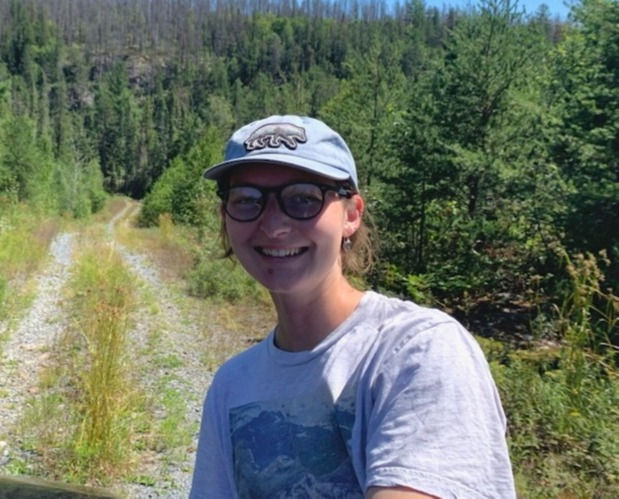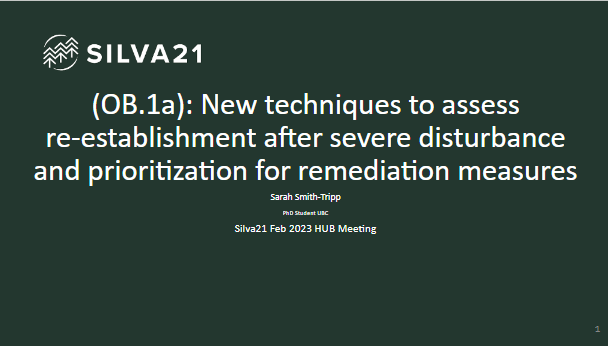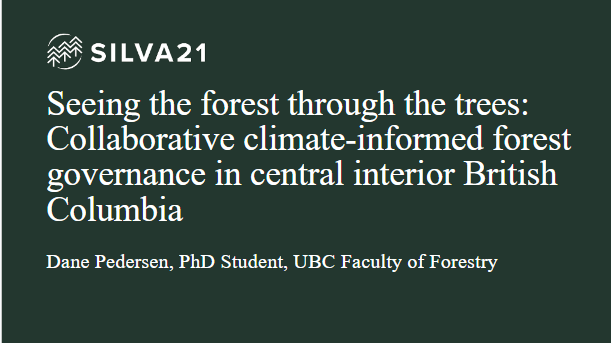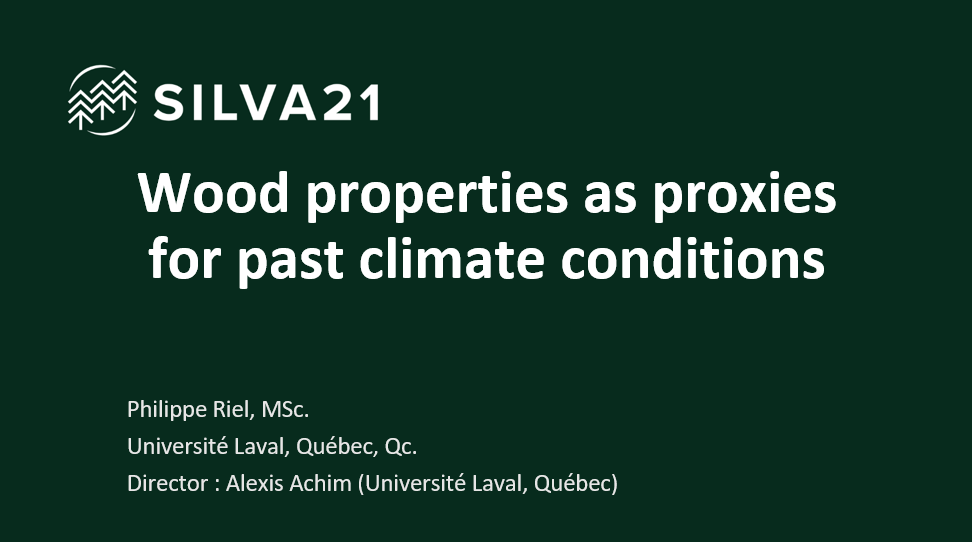Winter 2024 research updates
- Amy Wotherspoon

- Feb 13, 2024
- 1 min read
Updated: Mar 6, 2024
For its first meeting in the new year, the Silva21 community got together for our biannual update meetings to catch up on project updates, latest results and to promote discussion across research themes, hubs and institutions.
This winter our meetings were divided up into four themes and included new data from HQPs, as well as updates from government and industry partners, and field work updates for the upcoming summer!
Below are summary texts provided by the HQP for their projects. Click the research title and name below to read their update.
Selection management in northern hardwood stands affected by beech bark disease - Sébastien Dumont (PhD student, Université Laval)
Northern hardwood forests are affected by global change in many ways, but increasing stress from exotic pests and pathogens is of particular concern to forest managers and silviculturists. Beech bark disease is one specific major concern that affects most of American beech’s range in North America. In infected stands, implementing a fine-scale silviculture to mitigate the impact of the disease and promote more resilient beech populations for natural regeneration relies heavily on our ability to adapt tree marking for partial harvesting. We monitored several individual characteristics, including external signs of the beech bark disease, on 871 beech trees in recently infected northern hardwood stands in Quebec, to assess their ability to predict mortality over an eight-year period. Our results showed that the diameter at breast height, the levels of Neonectria perithecia coverage on the stem, crown dieback and to a lesser extent, the level of canker coverage on the bark had the best capacity to predict individual short-term mortality. Therefore, we propose the integration of specific harvest priorities for beech trees to guide tree marking operations: 1) maximum diameter of 20 cm, 2) moderate (10%-49%) to severe (50% -100%) cover of perithecia, 3) crown dieback ≥ 25%, and 4) a severe presence of canker on the bark. Special attention must also be given to the retention of large BBD-resistant trees in the infected stands.

Sébastien Dumont
PhD student
Université Laval
Supervisor: Alexis Achim
Integration of climate drivers into tree-list growth modelling in the Acadian forest region - Jamie Ring (MSc student, UBC)
To support climate-sensitive growth and yield modelling in the Acadian Forest Region, two existing tree-list growth and yield models developed for use in the Acadian Forest Region are being evaluated using Nova Scotia’s Permanent Sample Plot (PSP) data. The results from this evaluation will then be used to inform what model components are a priority (diameter increment, height increment, mortality, ingrowth) for incorporating climate sensitivity. Nova Scotia has a PSP dataset with approximately 3,000 individual plots that have been remeasured a combined 19,000 times, with nearly 1,000,000 individual tree observations. The simulations using Open Stand Model (OSM) and Forest Vegetation Simulator (FVS) – Acadian Variant are completed, and the results are being summarized to provide an in-depth look into the strengths and shortcomings of each model. Work is also underway to extract historical climate data specific to each PSP for fitting a climate-sensitive model component. Once a climate-sensitive model component is developed, it will be compatible with the existing framework of these growth and yield models, to assist in long-term forecasting of forest growth and yield under various climate scenarios.

Jamie Ring
MSc student
University of British Columbia
Supervisor: Bianca Eskelson
Silvicultural intensity and structural diversity in boreal mixedwoods - Ethan Ramsfield (MSc student, University of Alberta)
Silvicultural intensification is being used across the boreal forest to increase productivity. However, there are concerns about intensive silviculture reducing the complexity and heterogeneity of stands. This concept is based on the management of monocultures, with few studies looking at how silvicultural intensification impacts regenerating mixedwood forests, when multiple species are maintained. Mixedwoods play a crucial role in the boreal forest ecosystem, comprising a substantial portion of the landscape and providing numerous ecological benefits. In the Canadian boreal forest, mixedwoods are typically a mix of trembling aspen and white spruce. They provide numerous benefits over monocultures, including higher biodiversity, productivity, resilience to pests and pathogens, and are expected to respond better to climate change. The purpose of this study is to examine how increased intensity of silviculture treatments, while attempting to maintain a mixedwood forest type impacts the structural diversity and homogeneity when regenerating mixedwood stands. To answer this question data from the Timmins NEBIE site will be used. NEBIE, which stands for natural disturbance, extensive, basic, intensive and elite (referring to the intensity of silviculture), is a long term study across Northern Ontario looking at the impact intensive silviculture has on a variety of criteria and indicators.
Of the eight sites across Northern Ontario, data gathered from the Timmins site, which is a boreal mixedwood, will be used to answer the above question. The specific prescriptions for the Timmins site are:
- Natural: Unharvested.
- Extensive: Natural regeneration.
- Basic: Disc trenched, white spruce planted at 1800 sph, glyphosate sprayed throughout, removing about 80% of the aspen.
- Intensive: Perpendicular disc trench, white spruce planted at 2200 sph, 2 glyphosate
applications in 27 m wide strips with 3-6 m in between.
- Elite: Perpendicular disc trench, white spruce planted at 2200 sph, 2 selective glyphosate applications leaving 800-1100 sph aspen.
For this part of my project, the component of structural diversity that will be focused on is the non spatial component, specifically the density, basal area, and diameter distribution. In order to assess structural diversity and heterogeneity, the variation within each treatment was used. The main finding regarding density was Basic had the largest spread of density followed by Extensive, Natural, Intensive, and then Elite. For the basal area the Natural treatment was omitted. The findings showed that Basic, on average, had the most heterogeneous DBH distribution, followed by Elite, Intensive, and Extensive. Regarding basal area, basic also showed the highest diversity
between plots, followed by Elite, Extensive, and Intensive. Looking at how the species composition relates to these metrics, the Elite and Intensive treatments had the most even distribution of coniferous and deciduous species. These results suggest that using intensive silviculture, but aiming to maintain a mixedwood structure, may be an effective way to balance the need for timber production and maintaining biodiversity.

Ethan Ramsfield
MSc Student
University of Alberta
Supervisor: Brad Pinno
Determining the role of thinning on white spruce vulnerability to drought using a rainfall exclusion experiment - Chloe Larstone Hunt (MSc student, University of New Brunswick)
Drought is expected to increase in severity under current climate change projections which will have negative impacts on forest stands. As a result, silvicultural techniques in the Acadian forest must adapt to the expected change in drought regimes.
As a reminder, the objective of this experiment is to assess the capacity of pre-commercial thinning (PCT) to reduce negative drought impacts on white spruce (Picea glauca) plantations in the Maritimes. To test this, a fully crossed two-factor factorial drought experiment has been set up in Black Brook, New Brunswick. The first factor is artificial drought by means of rain exclusion, with three levels: control (no exclusion), 25% and 50% rain exclusion, while the second factor is stem density (mean ± SD), with three levels: control/ no thinning (1567 ± 220 trees ha-1), standard thinning (1333 ± 256 trees ha-1) and heavy thinning (938 ± 220 trees ha-1), for a total of nine unique combinations of treatments replicated twice in a randomized block design.
Data collected in 2023 is currently being analysed and processed with the goal of completing this by May 2023. Data includes tree growth, soil moisture, xylem water potential, and precipitation. Due to prolonged eavestrough damage in 2023 (which is now repaired), and an exceptionally wet summer, I am planning for an additional round of data collection during the 2024 growing season.
In terms of statistical analysis, there are two possible approaches. The first option is a plot-level analysis involving a two-factor ANOVA. The second, is a tree-level analysis involving a regression-type approach. The latter would require additional information such as tree-level estimates of density (tree mapping), and drought (interpolated soil moisture), and a competition index. An updated tree density count revealed that the PCT treatments are continuous across the plots, lacking the intended categorization/ levels (T0 = 2500, T1 = 1500, and T2 = 1000 trees ha-1). As a result, and in addition to prolonged eavestrough damage, a tree-level analysis is the more likely approach.
Since white spruce is likely expected to become increasingly maladapted to the projected warmer and drier conditions, conducting this experiment will aid in our understanding of the effect of PCT on white spruce drought sensitivity.

Chloe Larstone Hunt
MSc Student
University of New Brunswick
Supervisor: Loïc D'Orangeville
New techniques to assess re-establishment after severe disturbance and prioritization for remediation measures - Sarah Smith-Tripp (PhD Candidate, UBC)
After a wildfire, forest managers need to assess structural forest recovery because it can signal if management response is needed to maintain ecosystem services (e.g. timber). Given increasing wildfire severity and extent, satellite-based monitoring is particularly beneficial because satellites offer continuous spatial and temporal observations. However, it may be challenging to optimize optical imagery to explain the suite of forest metrics managers use to describe unique structural forest dynamics or patterns. There thus a need to understand how spectral dynamics relate distinct structural patterns of forest recovery. To create these structural patterns, I collected a chronosequence of forest structural measures using high-density RPASs (Remotely Piloted Aircraft) lidar for 1257 hectares of forest 5-, 8-, 12-, and 16-years post-fire. From RPAs lidar data and corresponding field plot measures, I predicted relevant attributes, including the percent bare ground, the proportion of coniferous trees, stem density, and basal area. I compared these structural attribute predictions with spectral recovery trajectories based on time series Landsat satellite indices. Using a clustering algorithm with inputs from seven spectral indices (NBR, NDMI, NDVI, TCA, TCB, TCG and TCW) I found 8 distinct spectral recovery trajectories (spectral clusters). When I investigated the patterns of forest structure within these clusters, we found that the clusters grouped into five patterns of structural recovery: strong coniferous regrowth, shelterwood, high mortality, coniferous:deciduous competition, and mixed forest regrowth. Of the two spatially dominant forest recovery patterns, one had a greater proportion of deciduous trees with some bare ground, and the other had a high stem density, but low basal area. The approach showcases the ability to use early spectral responses (5 years) to capture unique spectral trajectories and ensuant structural responses.

Sarah Smith-Tripp
PhD Candidate
University of British Columbia
Supervisor: Nicholas Coops
Seeing the forest through the trees: Collaborative climate-informed forest governance in central interior British Columbia - Dane Pedersen (PhD student, UBC)
British Columbia’s forest-dependent communities are intimately tied to the robustness and resiliency of the landscapes they inhabit. Following the most devastating summer of wildfire on record, these communities are struggling to respond to significant ecological changes stemming from the climate crisis, biodiversity loss and economic instability. Socio-cultural and political changes are also occurring – policies and initiatives that influence forest governance and management practices are happening at multiple temporal and geographical scales. My research seeks to analyze shifting human-ecological relationships as forest-dependent communities seek to adapt forest management practices to the impacts of climate change amidst the backdrop of efforts towards collaborative governance, meaningful reconciliation, and potentially, transformative change in the Quesnel Timber Supply Area (QTSA) and surrounding regions. To achieve this goal, I have created the following three research objectives:
Identify and analyze the relationships and power dynamics that exist within the QTSA as they relate to collaborative governance and decision-making so as to better understand the context, barriers, and opportunities for meaningful collaboration for forest management in an era of rapid social, political, and ecological change.
Driven by the goals of First Nations partners, co-design a legislative “roadmap” to support the development of the Nazko First Nation LUP through the identification of key values, priorities, policies, and leverage points as they relate to Indigenous land management and future forests.
Assess levels and logics of support for various climate informed forest management scenarios across various stake- and rightsholder groups in the QTSA through deliberative forums to identify interests in, capacities for, and barriers to transformational change.
As I prepare for my comprehensive exams, I am diving deep into literature on participatory action research (PAR) and decolonial methodologies. While I am thoroughly engaged in the material, I am challenged by a suite of important both methodological and ethical questions. What does being a settler ally in research look like? How can my research be beneficial for all parties involved? Am I getting this right? Instead of dwelling on the unknown, I will provide a quick overview of what I have learned from my readings.
PAR a specific kind of research that requires that participants be involved in the production and evaluation of the research process – in other words, participants are co-researchers. It is a methodology that challenges past injustices perpetuated through research by engaging in meaningful collaboration with communities that have been historically excluded from systems of power. PAR requires the politicization of participation in research and must be driven by the goals, needs, or problems identified by the community involved. However, PAR does not necessarily consider the historical or cultural context of the Indigenous experience in Canada, although it can be an appropriate methodology for conducting decolonial research. Decolonial research, then, engages and respects the lived experience of Indigenous peoples in Canada. It recognizes and investigates the fundamental assumptions of Western ontology and demands that principles of relationship and reciprocity remain and its core. While many questions remain, I remind myself that decolonization is an uncomfortable and difficult process. It is okay if I am not perfect – what matters is that I learn and that I always come to the table with empathy and humility.

Dane Pedersen
PhD Student
University of British Columbia
Supervisor: Shannon Hagerman
Detecting non-stand replacing disturbances in a near-real time context using Landsat and Harmonized Landsat Sentinel-2 time series - Madison Brown (MSc student, UBC)
Non-stand replacing disturbances (NSRs) are events that do not result in complete removal of trees and generally occur at a lower intensity over an extended period of time (e.g., insect infestation, drought), or at spatially variable intensities over shorter intervals (e.g., windthrow, partial burn, frost). These variable disturbance intensities and spatial patterns often lead to more heterogenous stand structures, and changes to the quality and quantity of biomass impacting timber supply and ecosystem services. Conventional inventory methods for monitoring NSRs are often conducted as part of annual aerial surveys which can be insufficient in both temporal and spatial resolution for managers tasked with adaptive decision making.
The increased accessibility of moderate spatial resolution satellite imagery with more frequent temporal revisit (e.g., 2-3 day return interval for Harmonized Landsat Sentinel-2 (HLS)) has seen an increase in algorithms designed to detect sub-annual change in forested landscapes over large spatial scales. The Bayesian Estimator of Abrupt change, Seasonal change, and Trend (BEAST) for example has shown promise with sub-annual change detection in temperate environments, with > 88 % detection of disturbances when compared to a validation data set.
Here we evaluate the sensitivity of BEAST to detect NSRs across a range of disturbance agents and severity levels in British Columbia (BC), Canada from 2002- 2020. To do so Landsat (2000-2016) and HLS (2016- 2020) data was utilized to create a 16-day composite normalized burn ratio (NBR) time series for 1.4M ha. This time series data was utilised by BEAST to produce change probability rasters. These change probabilities where then compared to the occurrence, severity and timings of disturbances as mapped by the BC annual aerial overview survey (AOS) data set. Differences in BEAST probability distributions between agents and levels of severity were compared to stands which were undisturbed using an HSD Tukey test analysis.
Results indicate than when compared to undisturbed stands, the BEAST disturbance probabilities where statistically different (p < 0.05) for the most prevalent insect disturbances within the region (i.e., Mountain Pine Beetle, Aspen Leaf Miner, Spruce Beetle amongst others) in addition to abiotic disturbances (i.e., non-biological injuries, fire, windthrow, avalanche and snowslides, landslides, aspen decline, and cedar flagging). Results also showed strong correspondence between the AOS polygons of very severe disturbances in all years in which they occurred in addition to strong correspondence for severe disturbance polygons in 15 of the 19 study years, and for medium disturbance polygons in 10 of the study years. This sensitivity of BEAST to a wide range of disturbance agents at varying intensities suggests promising opportunities for earlier detection of NSRs to inform continuous forest inventories.

Madison Brown
MSc student University of British Columbia
Supervisor: Nicholas Coops
Project Page
LiDAR-derived topographic variables to help find suitable sugar maple sites for assisted migration efforts - Joao Paulo Czarnecki de Liz (PhD student, ULaval)
Climate change poses uncertainties and challenges for forestry practices, necessitating adaptive measures to protect forests and their services. Assisted migration (AM) has emerged as a potential adaptation strategy to conserve ecosystems and maintain forest production. Implementation of AM requires a comprehensive analysis considering various factors. Spatial distribution models (SDMs) incorporating multivariate approaches and topographical factors have become increasingly important in assessing habitat suitability and planning species management. High-resolution terrain data derived from LiDAR facilitates the characterization of terrain microrelief, aspect, slope, and other topographical indexes, enabling a finer-scale representation of ecological processes. While previous research efforts have aimed to support the implementation of AM at an operational scale through various studies and experiments, a more comprehensive characterization of potential sites at the stand level is essential to mitigate risks of failure.
This study focuses on the sugar maple (Acer saccharum), a commercially valuable species in North America expected to shift its range northwards in response to climate change. The objective of this work was to examine the extent to which topographical factors can enhance SM distribution modeling and the degree to which these factors determine sites that are suitable for SM under different future climate scenarios. By examining the responses of sugar maple to biotic and abiotic factors, particularly in its northernmost range, we aim to gain insights into its ecological requirements and develop effective management strategies for its survival and growth.
Our findings suggest that slope, topographical position, and elevation are the most significant topographical variables with the potential to enhance sugar maple distribution modeling and explain its presence in the study region. Climate projections suggest the species may expand habitat in downslope, mid-slopes, and valleys with minor increases in temperature and precipitation averages. The study area shows an increase in suitable areas but also a slight decrease within the first 30 years under the most optimistic climate scenario (SSP126). These results can support the implementation of AM at stand level scale and with the spatially explicit representations it can provide practical references for practitioners to guide their actions in the field. The results also highlight that certain changes in specific areas are likely to occur more rapidly than expected, necessitating swift response measures.

Joao Paulo Czarnecki de Liz
PhD student
Université Laval Supervisor: Alexis Achim
Wood properties as proxies for past climate conditions - Philippe Riel (MSc student, ULaval)
Drew et al. 2009, showed that MFA in eucalyptus decreased during a drought and increased during an irrigation period.
My project is an exploration of a method using Raman confocal microscopy to see if we can find this same effect but on black spruce in the boreal forest. For my preliminary results, I have a lot a variability in earlywood and latewood. So far, I have found an almost significant relationship between MFA and the amount of degree days for the most severe drought during the earlywood and latewood formation periods. I’m currently working on my data to find interesting relationships between my variables, and I will carry out further tests by varying the minimum precipitation threshold for characterizing the maximum drought event.
One of the challenges I face in my statistical analysis, is my relatively limited number of observations and the variability in my angle values. Due to the technique used to measure the MFA, I have to deal with a limited number of samples. This method allows us to measure MFA in one cell wall very precisely but it’s extremely time-consuming.

Philippe Riel
MSc Student
Université Laval
Supervisor: Alexis Achim
Beyond common gardens: assessing the influence of heterogeneity on the success of assisted migration - Lisa Han (PhD student, University of Toronto)
As climate change persists, our forest systems are experiencing rapid environmental shifts outpacing the natural migration rates of tree species. This necessitates assisted migration as a critical strategy for enhancing forest resilience against future climate scenarios. Assisted migration involves relocating genetic material from its home climate to new habitats predicted to undergo similar climate changes. However, the effectiveness of different provenances in assisted migration experiments varies, highlighting the importance of understanding how local site environments and microclimates influence the phenological and allocation strategies of different provenances. Incorporating detailed analysis of local site conditions such as soil properties, microclimate variations, and biotic interactions is important in predicting survival and growth outcomes as well as long-term success.
Using both observational and experimental plots established in Petawawa Research Forest, I aim to uncover mechanisms underlying the effects of transfer distance and different treatments (thinning/gaps; competition driven by vegetation communities) and the interaction between the treatments and transfer distance along with topographic variations. The effects of intraspecific variation in phenological patterns and resource allocation on growth and survival will be achieved through both observational data and destructive sampling within experimental plots. The role of competition and facilitation will be assessed to help understand the mechanistic drivers shaping the outcomes of assisted migration trials. Contingent on extreme weather conditions or simulation of extreme weather events, drought and frost risks will be assessed as these responses can be a better indicator of persistence and the long-term health of trees at the site.

Lisa Han
PhD student
University of Toronto
Supervisor: John Caspersen
If you are a member of the Silva21 team and would like to receive a copy of all slides, log in to our Members Area. Forgot the password? Email amy.wotherspoon@ubc.ca
Our next update meetings will take place at the Annual General Meeting, May 7 - 9th in Ottawa, Ontario!














Comments